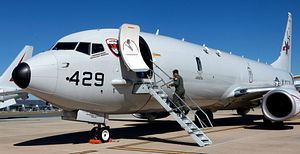Australia’s first Boeing P-8A Poseidon maritime patrol aircraft, dubbed ‘Aussi 01,’ has completed its maiden flight in the United States on May 16, according to statement released by the Australian Department of Defense (DoD), IHS Jane’s Defense Weekly reports.
The aircraft took off from Renton Field in Washington State and safely landed at nearby Boeing Field where its mission systems, including an advanced multi-mode radar, a high definition electronic optic camera, an acoustic system, and an advanced electronic support system, will be installed.
The new fleet of P-8A Poseidon aircraft is slated to replace the 15 Lockheed AP-3C Orion maritime patrol aircraft currently in service with the Royal Australian Air Force (RAAF).
According to the 2016 Defense White Paper released by the Australian DoD, “[e]ight P-8A Poseidon maritime surveillance and response aircraft will be introduced in the early 2020s.” Initial operating capability (IOC) for the eight aircraft of the first tranche is scheduled for the period 2017-2020, with full operating capability by 2021.
The estimated price tag for the first eight aircraft is A$4 billion ($3.6 billion), including the cost of support facilities.
The RAAF will receive a total of 15 P-8A Poseidon aircraft in two tranches by the late 2020s. In January 2016, the U.S. Navy awarded Boeing with a $2.5 billion contract for the construction of 20 new P-8A Poseidon Maritime Surveillance Aircraft, including four planes for the RAAF.
“This contract combines purchase for the Navy ($2,052,571,034; 83 percent); and the Government of Australia ($417,011,961; 17 percent), under a cooperative agreement,” U.S. Department of Defense press release read (See: “US Navy Orders 20 New Anti-Submarine Warfare Planes”).
Australia first announced the defense deal in February 2014. The aircraft will “dramatically boost Australia’s ability to monitor its maritime approaches and patrol over 2.5 million square kilometers of our marine jurisdiction,” then-Prime Minister Tony Abbott and Defense Minister David Johnston, said in a joint statement.
The P-8A Poseidon is a military variant of Boeing’s Next-Generation 737-800 commercial airplane equipped with advanced anti-submarine, anti-surface warfare and intelligence, surveillance, and reconnaissance capabilities.
According to the Boeing website, the P-8A aircraft “has twice the sonobuoy processing capability and can carry 30 percent more sonobuoys than any maritime patrol and reconnaissance aircraft currently flying.”
The aircraft has an internal fuel capacity of 34 tons providing it with a maximum range of 7,242 kilometers (4,500 miles) without refueling. The P-8A can “remain on station conducting low level Anti Submarine Warfare (ASW) missions for over four hours at a range of more than 1,200 nautical miles (2,200 km) from base,” according to the RAAF website.
“The P-8A has 11 weapon hard points (five in the bomb bay, four under the wings and two under the fuselage) and can carry over 22,000 pounds (10,000kg) of weapons,” the RAAF explains. Weapons include Raytheon Mark 54 lightweight torpedoes, which are turned into glide bombs and can be launched from up to 9,100 meters, mines, depth charges, and Harpoon air-to-surface missiles.

































